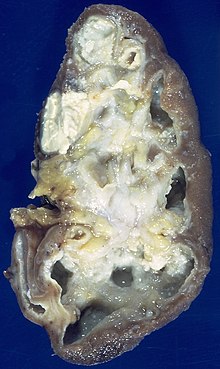| Caseous necrosis | |
|---|---|
 | |
| Micrograph showing caseous necrosis of a tuberculous lymph node. H&E stain. Histological specimens are normally obtained from supraclavicular lymph nodes to demonstrate caseous necrosis. | |
 | |
| Subpleural caseous necrosis (Ghon focus) | |
| Specialty | Pathology |
| Complications | Lung cavity |
| Causes | Tuberculosis |
Caseous necrosis or caseous degeneration (/ˈkeɪsiəs/) is a unique form of cell death in which the tissue maintains a cheese-like appearance. Unlike with coagulative necrosis, tissue structure is destroyed. Caseous necrosis is enclosed within a granuloma. Caseous necrosis is most notably associated with tuberculoma. The dead tissue appears as a soft and white proteinaceous dead cell mass.
The term caseous means 'pertaining or related to cheese', and comes from the Latin word caseus 'cheese'.
Histology

In caseous necrosis no histological architecture is preserved (unlike with coagulative necrosis). On microscopic examination with H&E staining, the area is acellular, characterised by amorphous, roughly granular eosinophilic debris of now dead cells, also containing interspearsed haematoxyphilic remnants of cell nucleus contents. This caseus necrotic center is enclosed within a granuloma.
Causes
Frequently caseous necrosis is characteristically associated with tuberculomas.
A similar appearance can be associated with histoplasmosis, cryptococcosis, and coccidioidomycosis.
Pathophysiology
This begins as infection is recognized by the body and macrophages begin walling off the microorganisms or pathogens. As macrophages release chemicals that digest cells, the cells begin to die. As the cells die they disintegrate but are not completely digested and the debris of the disintegrated cells clump together creating soft granular mass that has the appearance of cheese. As cell death begins, the granuloma forms and cell death continues the inflammatory response is mediated by a type IV hypersensitivity reaction.
Some data suggests that the epithelioid morphology and associated barrier function of host macrophages associated with granulomas may prevent effective immune clearance of mycobacteria.
References
- "caseous degeneration". TheFreeDictionary.com. Retrieved 2019-09-05.
- ^ "Caseous | Meaning of Caseous by Lexico". Lexico Dictionaries | English. Archived from the original on September 3, 2021.
- Robbins and Cotran: Pathologic Basis of Disease, 8th Ed. 2010. Pg. 16
- "caseous - WordReference.com Dictionary of English". www.wordreference.com.
- ^ Cross, Simon S. (2013). Underwood's Pathology (6th ed.). Churchill Livingstone. p. 84. ISBN 978-0-7020-4672-8.
- ^ Strayer, David S.; Rubin, Emanuel; Saffitz, Jeffrey E.; Schiller, Alan L., eds. (2015). Rubin's Pathology: Clinicopathologic Foundations of Medicine (7th ed.). Philadelphia: Wolters Kluwer Health. p. 35. ISBN 978-1-4511-8390-0.
- ^ Kumar, Vinay; Abbas, Abul K.; Aster, Jon C., eds. (2015). Robbins and Cotran pathologic basis of disease (Ninth ed.). Philadelphia, PA: Elsevier/Saunders. p. 43. ISBN 978-1-4557-2613-4.
- "Pulmonary Pathology". Retrieved 2008-11-21.
- ^ "Cellular changes and adaptive responses – Knowledge for medical students and physicians". www.amboss.com. Retrieved 2019-09-05.
- "Tuberculosis". webpath.med.utah.edu. Retrieved 2019-09-05.
- Bhattacharya, Mallar (2016-11-09). "Macrophages build a wall and the host pays for it". Science Translational Medicine. 8 (364): 364ec178. doi:10.1126/scitranslmed.aal0066. ISSN 1946-6234. S2CID 51606274.
External links
- Microscope images of caseous necrosis
- Image of a hilar lymph node demonstrating caseous necrosis
- Image of a caseating granuloma of tuberculosis in the adrenal gland
| Pathology | |
|---|---|
| Principles of pathology | |
| Anatomical pathology | |
| Clinical pathology | |